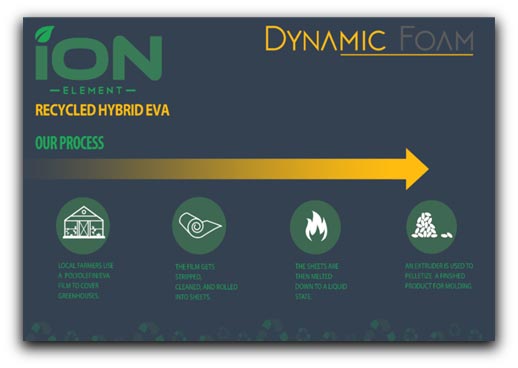Polyurethane or PU has been a staple in the footwear world for decades. While it served a purpose – mainly low-cost die-cut footbeds, it has certainly not done the industry any favors in terms of the charge towards more sustainable product.
Many footwear brands continue to use PU most likely because it’s what they have BEEN using – it’s easy. Customers have come to expect the cheap and flimsy 4mm standard sockliner when they purchase a pair of shoes. There is a slight cushion feel when they try them on and after that – the sockliners are either thrown out (making it even less sustainable) and replaced by an aftermarket insole or left in to provide little to no arch support for the life of the shoe.
There are manufacturing and post-application hazards of polyurethane. In manufacturing – Both isocyanates and polyols emit heat and vapor when mixed to form polyethylene. The dangers of isocyanates are well-documented. They cause irritation and sensitization. Vapors and aerosols released during and after mixing side A and B chemicals up to the time the polyurethane is cured can cause asthma, lung damage, other respiratory and breathing problems, skin and eye irritation, and cancer. The Environmental Protection Agency has guidelines for personal safety for those who work with or are exposed to polyurethane vapors. Post-application, VOCs like toluene diisocyanate and formaldehyde can be emitted from the foam, especially when it is newly manufactured.
Recycled polyurethane is post-industrial, essentially meaning factory scrap. The amount of ‘scrap’ produced by virgin PU products is not regulated, so it is difficult to determine the amount of waste actually being kept out of landfills. While some PU sockliners are touted as “eco products” or are GRS Certified, it is important to note that they do not use post-consumer recycled material. The ‘recycled’ content percentages are also typically minimal as the scrap can affect consistency of the material.
The footwear and fashion industry as a whole is historically ‘dirty’, but the good news is that there are a lot of companies out there making great strides towards better materials. They are available today and have proven track records of durability and performance.
One of these better alternatives is EVA. EVA foam is more versatile, more sustainable and a better product when compression molded into shaped insoles or midsoles. EVA is durable and consistently meets brand performance specifications and standards. It can be recycled not only post-industrial, but also post-consumer. So despite the fact that it is a petroleum based material – the life can be extended over and over with recycling methods. Compared to PU – EVA has lower energy consumption during recycling and manufacturing processes.
Since Dynamic Foam’s line of Recycled EVAs (iON Element™, Real Recycled, and Recycled +Bloom™) have been in the market – over 2 million KG (and counting) of waste has been kept out of landfills. It is estimated that every 6 prs of insoles saves 1lb of waste from going to landfills. Dynamic Foam is transparent about our recycling and manufacturing processes – and all of our recycled compounds are GRS Certified.
Recycled EVA can also be combined with bio materials for what we refer to as ‘the best of both worlds’. The recycled EVA provides the performance and recycled content, while the bio portion is generally renewable and has several peripheral benefits.
The switch to Dynamic Foam’s GRS Certified Post-Consumer Recycled EVAs can be easy and come with a minimal cost. The product itself is extremely cost-effective due to the lower cost of the recycled EVA sheets (from greenhouses) used. Dynamic Foam has a fleet of universal molds at our Vietnam facility that can be used for molded insoles at no cost to the brand. Additionally, there are options to purchase EVA sheets or blockers and have them shipped to existing factories for finishing. Our team will work directly with the T1 factories to ensure a streamlined material change.

